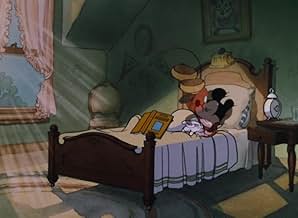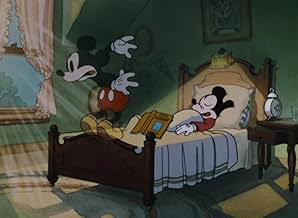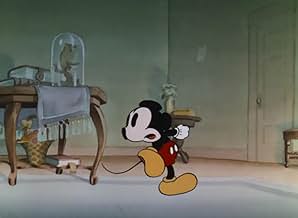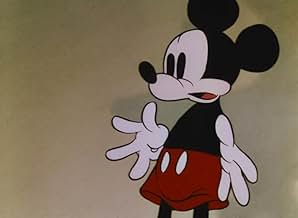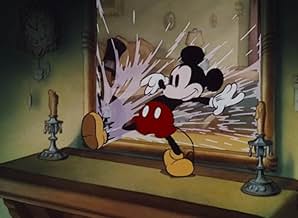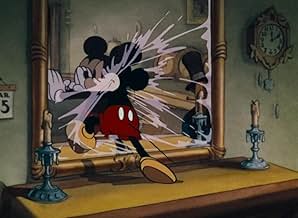VALUTAZIONE IMDb
7,5/10
2997
LA TUA VALUTAZIONE
Topolino sta leggendo un libro ma si addormenta. Al suo risveglio, riesce ad attraversare lo specchio "magico" di casa sua, andando dall'altra parte.Topolino sta leggendo un libro ma si addormenta. Al suo risveglio, riesce ad attraversare lo specchio "magico" di casa sua, andando dall'altra parte.Topolino sta leggendo un libro ma si addormenta. Al suo risveglio, riesce ad attraversare lo specchio "magico" di casa sua, andando dall'altra parte.
- Regia
- Sceneggiatura
- Star
Pinto Colvig
- Radio Hiccup
- (voce)
Walt Disney
- Mickey Mouse
- (voce)
- (non citato nei titoli originali)
Recensioni in evidenza
When "Thru the Mirror" begins, Mickey has just fallen asleep after reading Lewis Carroll's "Through the Looking Glass". Then, like in the story, Mickey has a dream where he, too, is able to talk through the mirror into a strange parallel world. He finds that all the furnishings in the house are alive. Next, he eats a walnut and shrinks--and has all sorts of miniature adventures. He battles against some playing cards but my favorite portion is where he tap dances--in a manner highly reminiscent o Fred Astaire. All in all, there really isn't a lot in the way of plot but the cartoon is so much fun and the animation so nice that you really don't care! Clever and fun from start to finish.
Fun Disney take on Lewis Carroll's "Through the Looking Glass." Here Mickey Mouse falls asleep reading that book, then his spirit leaves his body and goes through a mirror. On the other side of the mirror is a wacky version of Mickey's house where the inanimate objects have come to life. A lot of really cool trippy stuff follows that I don't want to spoil for you. Needless to say it's awesome to watch, especially for the time in which it was made. The animation is top-notch (it was Disney, after all). The characters and backgrounds are all well-drawn and the action is excitingly realized. Love the music, too. Fine voice work from Walt Disney. This is as wacky and creative as it gets for 1936 and I can't imagine anyone not having a good time with it. Just a fun cartoon from start to finish.
10baz-15
This was made in the golden age of Disney animation (1935-1940). It involves mickey's adventures as he goes 'thru' the mirror and enters a world where inanimate objects are alive. there are many impressive bits. for example the scene where mickey eats a nut and is transformed in size is brilliantly done. there is a lot of dancing in the cartoon, mickey dances with a top hat and a pair of gloves and does a dance routine with some playing cards, and then there is a busby berkley type dance thing involving the cards. the climax involves mickey being chased by hundreds of cards and it is fantastic. you have to hand it to the artists who worked on this, it is a great cartoon. other superior mickey mouse cartoons include: the band concert(1935); mickey's garden(1935); clock cleaners(1937); moving day(1936); the sorcerer's apprentice (from fantasia (1940) ).
Fantastic, I remember me being younger and seeing this short, even very good. I highly recommend it.
A Walt Disney MICKEY MOUSE Cartoon.
Like the famous literary Alice, Mickey goes THRU THE MIRROR to find himself in a very strange room where almost anything can happen...and probably will.
Here is one of the classic Mouse films - an exercise in sheer exuberant delight. Taking Lewis Carroll as the departure point, the Disney artists crafted a tale of visual excitement & great good fun. Music propels the action and Mickey's joyous dance - backed up by matches, white gloves & a whole pack of cards - proves to be a salute to both Fred Astaire & Busby Berkeley. The Queen of Hearts card - the Mouse's soulful dancing partner at one point - is a spoof of Greta Garbo. Look fast near the end for a quick cameo by King Neptune, who starred in his own SILLY SYMPHONY back in 1932. Walt Disney provides Mickey with his squeaky voice.
Walt Disney (1901-1966) was always intrigued by drawings. As a lad in Marceline, Missouri, he sketched farm animals on scraps of paper; later, as an ambulance driver in France during the First World War, he drew figures on the sides of his vehicle. Back in Kansas City, along with artist Ub Iwerks, Walt developed a primitive animation studio that provided animated commercials and tiny cartoons for the local movie theaters. Always the innovator, his ALICE IN CARTOONLAND series broke ground in placing a live figure in a cartoon universe. Business reversals sent Disney & Iwerks to Hollywood in 1923, where Walt's older brother Roy became his lifelong business manager & counselor. When a mildly successful series with Oswald The Lucky Rabbit was snatched away by the distributor, the character of Mickey Mouse sprung into Walt's imagination, ensuring Disney's immortality. The happy arrival of sound technology made Mickey's screen debut, STEAMBOAT WILLIE (1928), a tremendous audience success with its use of synchronized music. The SILLY SYMPHONIES soon appeared, and Walt's growing crew of marvelously talented animators were quickly conquering new territory with full color, illusions of depth and radical advancements in personality development, an arena in which Walt's genius was unbeatable. Mickey's feisty, naughty behavior had captured millions of fans, but he was soon to be joined by other animated companions: temperamental Donald Duck, intellectually-challenged Goofy and energetic Pluto. All this was in preparation for Walt's grandest dream - feature length animated films. Against a blizzard of doomsayers, Walt persevered and over the next decades delighted children of all ages with the adventures of Snow White, Pinocchio, Dumbo, Bambi & Peter Pan. Walt never forgot that his fortunes were all started by a mouse, or that simplicity of message and lots of hard work will always pay off.
Like the famous literary Alice, Mickey goes THRU THE MIRROR to find himself in a very strange room where almost anything can happen...and probably will.
Here is one of the classic Mouse films - an exercise in sheer exuberant delight. Taking Lewis Carroll as the departure point, the Disney artists crafted a tale of visual excitement & great good fun. Music propels the action and Mickey's joyous dance - backed up by matches, white gloves & a whole pack of cards - proves to be a salute to both Fred Astaire & Busby Berkeley. The Queen of Hearts card - the Mouse's soulful dancing partner at one point - is a spoof of Greta Garbo. Look fast near the end for a quick cameo by King Neptune, who starred in his own SILLY SYMPHONY back in 1932. Walt Disney provides Mickey with his squeaky voice.
Walt Disney (1901-1966) was always intrigued by drawings. As a lad in Marceline, Missouri, he sketched farm animals on scraps of paper; later, as an ambulance driver in France during the First World War, he drew figures on the sides of his vehicle. Back in Kansas City, along with artist Ub Iwerks, Walt developed a primitive animation studio that provided animated commercials and tiny cartoons for the local movie theaters. Always the innovator, his ALICE IN CARTOONLAND series broke ground in placing a live figure in a cartoon universe. Business reversals sent Disney & Iwerks to Hollywood in 1923, where Walt's older brother Roy became his lifelong business manager & counselor. When a mildly successful series with Oswald The Lucky Rabbit was snatched away by the distributor, the character of Mickey Mouse sprung into Walt's imagination, ensuring Disney's immortality. The happy arrival of sound technology made Mickey's screen debut, STEAMBOAT WILLIE (1928), a tremendous audience success with its use of synchronized music. The SILLY SYMPHONIES soon appeared, and Walt's growing crew of marvelously talented animators were quickly conquering new territory with full color, illusions of depth and radical advancements in personality development, an arena in which Walt's genius was unbeatable. Mickey's feisty, naughty behavior had captured millions of fans, but he was soon to be joined by other animated companions: temperamental Donald Duck, intellectually-challenged Goofy and energetic Pluto. All this was in preparation for Walt's grandest dream - feature length animated films. Against a blizzard of doomsayers, Walt persevered and over the next decades delighted children of all ages with the adventures of Snow White, Pinocchio, Dumbo, Bambi & Peter Pan. Walt never forgot that his fortunes were all started by a mouse, or that simplicity of message and lots of hard work will always pay off.
Lo sapevi?
- QuizThis short is featured as a playable level in the video game Epic Mickey: La Leggendaria Sfida di Topolino (2010).
- BlooperThere is a series of scratches visible throughout, apparently from the platten glass used to hold the artwork under the camera.
- Citazioni
King of Hearts: [top half] Call out the cards!
King of Hearts: [bottom half] Call out the cards!
King of Hearts: [both halves] Call out the cards! Call out the cards!
Radio: [repeatedly] Calling all cards. Calling all cards.
- ConnessioniEdited into Topolino Story (1968)
I più visti
Accedi per valutare e creare un elenco di titoli salvati per ottenere consigli personalizzati
Dettagli
- Data di uscita
- Paese di origine
- Lingua
- Celebre anche come
- Attraverso lo specchio
- Azienda produttrice
- Vedi altri crediti dell’azienda su IMDbPro
- Tempo di esecuzione
- 9min
- Proporzioni
- 1.37 : 1
Contribuisci a questa pagina
Suggerisci una modifica o aggiungi i contenuti mancanti

